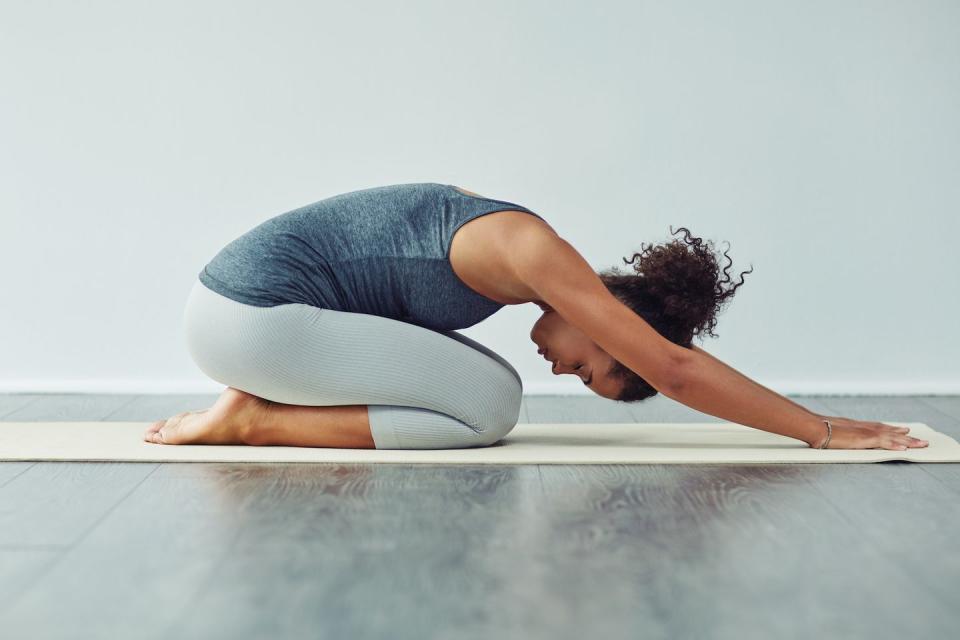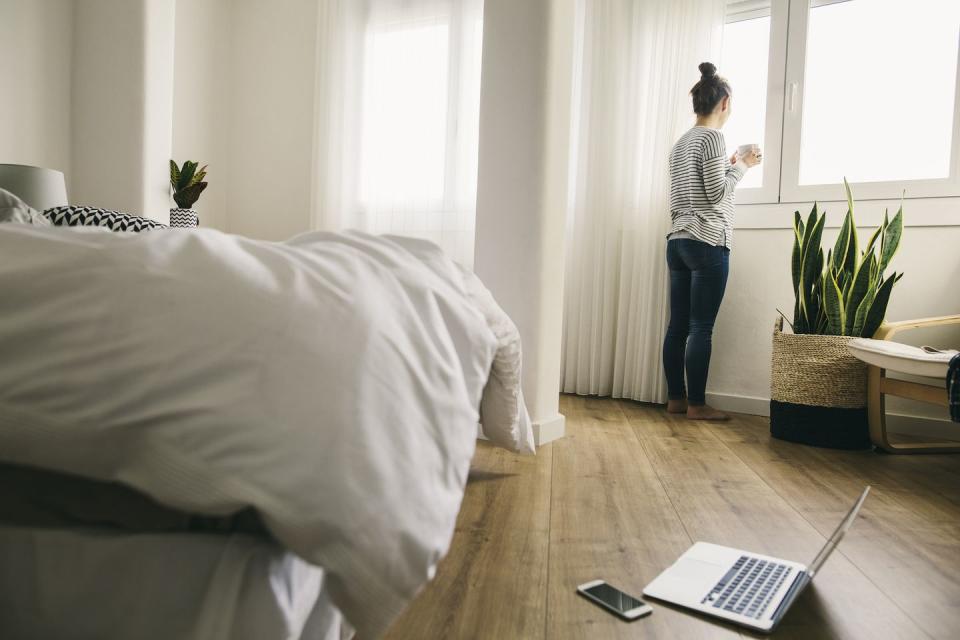Yoga to ease lower-back pain caused by working from home

While the world gets to grips with a new way of living during the coronavirus pandemic, many of us are also having to adapt our days to working from home.
Whether you've cobbled together a make-shift desk from existing furniture, are using your kitchen counter as a stand-up desk, or are simply sat on the sofa, laptop on lap, working at from home for endless hours is proving taxing on not only your patience and mind, but also your back.
While there are many causes of back pain, such as a having a bad night’s sleep, illness and stress, it can also be caused by prolonged periods of time in one position with minimal movement.
"During these challenging times of home working, it is important to remember that without your normal desk set up, there are many ways to care for your back and prevent pain," says Lisa Osborn-Jenkins, specialist musculoskeletal physiotherapist from the Chartered Society of Physiotherapy (CSP).
"There is no perfect sitting position, there is just too much sitting in one go. Without your walk to work, a trip out for lunch and normal exercise regime, inactivity levels may be more of a problem for your back. The most important thing to do is to break up your inactivity with activity, as exercise is shown to be the most effective strategy to prevent back pain."

In 2017, a study published by the University of Maryland School of Medicine in the US analysed more than 1,000 men and women with long-term term lower back pain and found that those who practised yoga were most likely to reduce their symptoms.
Meanwhile, a UK study from 2011 found that offering a 12-week yoga programme to adults with chronic or recurrent lower back pain was found to have greater benefits than usual care.
So, if you’re struggling with lower back pain while working from home, yoga might be the answer to your aches and pains.
We spoke to several yoga and physiotherapy experts to find out how best to ease lower-back pain using yoga:
How can we avoid lower-back pain while working from home?
You’ve no doubt played musical chairs in your house several times a day so far, moving from the sofa to the bed, over to the kitchen stool or the dining table chairs to find a comfortable sitting position - only to find that nothing is really that comfortable for long.
However, with a lack of access to ergonomic office chairs to provide support and relief for muscles and joints, many are experiencing pain in the lower back from being hunched over laptops or being sat at the wrong height.
As a result, several yoga experts have suggested exercises to help loosen up joints and keep core and back muscles strong.

They all agree that it is essential to get up from your chair and move around frequently.
"If possible, move your desktop around. I go from the floor, to a bolster, to a chair to standing," says yoga teacher and movement coach Kim Hartwell. "Often we get pain in the lower back as a result of tight hips and hamstrings. It’s more often than not that these muscles are actually weak too, so the best thing we can do is strengthening exercises like squats, lunges and bridges rather than stretching alone."
Meanwhile, yoga teacher Georgia Wood (@backtoyouyoga) advises workers to "come into a child’s pose with wide knees (holding the posture for 10 long breaths) and practice some cat-cows" to break up your working positions.
While many people might assume that doing backbends will ease lower back pain, yoga teacher Lydiana Abbott (@kuasayoga) says that, in her experience, it can actually exacerbate issues.
"It is most likely that you’re experiencing pain because a part of your spine is taking the hit, for example, too much pressure is being put onto one part of the spine," she says.
"What you want to do is lengthen and strengthen the spine to prevent further damage and release the pressure. However, every body is different and one exercise might not work for someone and could do really well for somebody else."
As a result, she notes, it’s important to try out which exercises work well for you and if something feels uncomfortable or painful, don’t force it.
Which yoga exercises can we do to ease lower-back pain?
Spinal twists and glute-strengthening exercises like lunges, squats and bridges are great to alleviate joint and muscle pain, but there are also specific yoga-inspired moves that can aid pain relief in a more targeted way.
Here is a list of exercises to try:
Downward dog
Abbott suggests: "Create an upside-down V shape with body, with hands and feet on the ground.
"Have a micro-bend in the legs and stick your bum up to the ceiling. The intention is to create more space for the spine to lengthen and a safer stretch for the hamstrings."
Half-dog pose
"Bring your knees to the ground and have your hips lined up on top of them," Abbott explains.
"Bring your hands forwards and the forehead might come to touch the ground in between the arms. Similar benefits to downward dog, and it’s easier on the hands, arms and shoulders."
Cat-cow
Wood suggests this is a great exercise to get some movement in your spine and a release for the lower back.
To do this, she advises: "Come to hands and knees.
Inhale and lift your tailbone and the crown of your head, looking to the ceiling - arching the spine.
Exhale and drop your head and tailbone, pushing up into your mid-back - rounding the spine.
Repeat 10 times, moving with your breath."
Child’s pose
"This done with wide knees is a great posture to release the lower back and ground and calm us," Wood notes.
From all fours, bring the knees slightly wider apart, big toes come to touch behind you.
Draw your hips back towards the heels (don’t worry if they don’t touch the heels but keep drawing them back and down).
Stretch your arms out in front of you and let your head come towards the ground, if it doesn’t touch the ground you can rest it on a thick book.
Stay here with eyes closed for at least 10 long breaths.

Supine twist
Described as a "lovely release of the back and glutes," Wood says:
Lying on your back, draw your right knee up towards your chest.
Use your left hand to draw the knee across the body to the left side - coming into a twist.
Make sure your right shoulder is stuck to the ground.
Let your right arm come out 90 degrees and look over the right shoulder, completing the twist to the top of your spine.
Hold for 10 deep breaths.
Repeat on the other side.
What is the preferred way to sit to alleviate pain?
There is no ‘correct’ way to sit, other than the one that feels most comfortable for you. Some people may prefer to work at a desk and sit upright, while others may prefer to lie in bed for ultimate comfort and relaxation.
However, according to Osborn-Jenkins, if you really want to reduce your lower back pain, "any change of position should give you some relief".
"If you are working from a laptop you may find it more comfortable working at a table, so you can see your screen with more ease and comfort," she says.

"A chair that provides some support for your lower back (you could add a cushion or two) and your screen near eye level is best. Many people get back pain while trying to sit in a “good posture” because their muscles have to work very hard to keep them upright. It is ok to slump as your back is designed to bend, but just like any part of your body, it will not thank you to stay there all day."
Using yoga to reduce pain, Hartwell suggests lying down on your front to release the hips or sitting on a block or book to have better posture.
So should we be varying the way we’re sitting throughout the day?
"Your body is always going to hold itself in the easiest way possible," says Abbott.
"What this means is that certain parts of the body take the pressure and your weight. Varying up how you are seated means it can’t do this."
If you find yourself sitting in one position the whole day, perhaps due to special constraints or work obligations, then it’s essential you’re doing other movements to compensate this, whether this is yoga, Pilates, running or dancing.

"Sitting positions that are comfortable for some, will not be for others," adds Osborn-Jenkins.
"Instead of varying the way you sit, aim for regular breaks. Keeping active can also help you deal with life stressors, so make sure you are finding ways to stay active."
How often should we be having breaks from sitting?
If you wear a fitness tracker and regularly find it buzzing to let you know you need to stand up, you’ll know how important it is to break up sitting with regular movement.
"Most people should not sit for more than 30-60 minutes without a break for good back health," says Osborn-Jenkins.
"Although there is not enough evidence to set a time limit on how much people should sit each day, sitting too long can lead to other health concerns (such as diabetes). So, find ways to move more and sit less - this could be setting a timer on your computer as a reminder or making all phone calls standing up."

The physiotherapist says that just two minutes of activity, such as walking or putting the washing out, can help break up sitting times.
"Aim to be physically active every day; any activity is better than none and it should be something you enjoy," she notes.
"Per week this should total to 150 minutes of moderate activity or 75 minutes of vigorous activity. You may find that simple back movements like gentle twists lying down, hugging your knees to your chest and gentle backward stretches prepares your back for activity and gives you some relief."
From a yoga teacher’s perspective, Hartwell suggests sitting in a squat-sit position (malasana) and opening the hips with stretches like couch stretch, pigeon or lizard to alleviate back pain.
In need of some at-home inspiration? Sign up to our free weekly newsletter for skincare and self-care, the latest cultural hits to read and download, and the little luxuries that make staying in so much more satisfying.
Plus, sign up here to get Harper’s Bazaar magazine delivered straight to your door.
You Might Also Like

